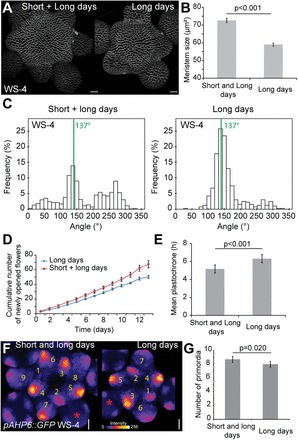Fig. 4.

Impact of day length on the robustness of phyllotaxis in WS-4. (A) Representative WS-4 meristems labelled with FM4-64 and grown in two different conditions. Scale bars=20 μm. (B) Meristem size in plants grown in short and long days (n=29) or in long days only (n=15), two-tailed Student test. (C) Distribution of divergence angle frequencies between successive siliques in plants grown in short and long days (1046 angles, 25 plants) or in long days only (487 angles, 15 plants). (D) Cumulated number of newly opened flowers in short and long days (n=17 plants) or in long days (n=14 plants). (E) Mean plastochrone calculated from the first 10 d of flower production (two-tailed Student test). (F) Representative meristems from pAHP6::GFP lines grown in two different conditions. GFP signal intensity is represented using the ImageJ Fire lookup table. Scale bars=20 μm. (G) Number of GFP-positive stage 1 and 2 primordia in meristems from plants grown in two different conditions (n=17 meristems for short and long day condtion and n=16 for long day condition, two-tailed Student test).
